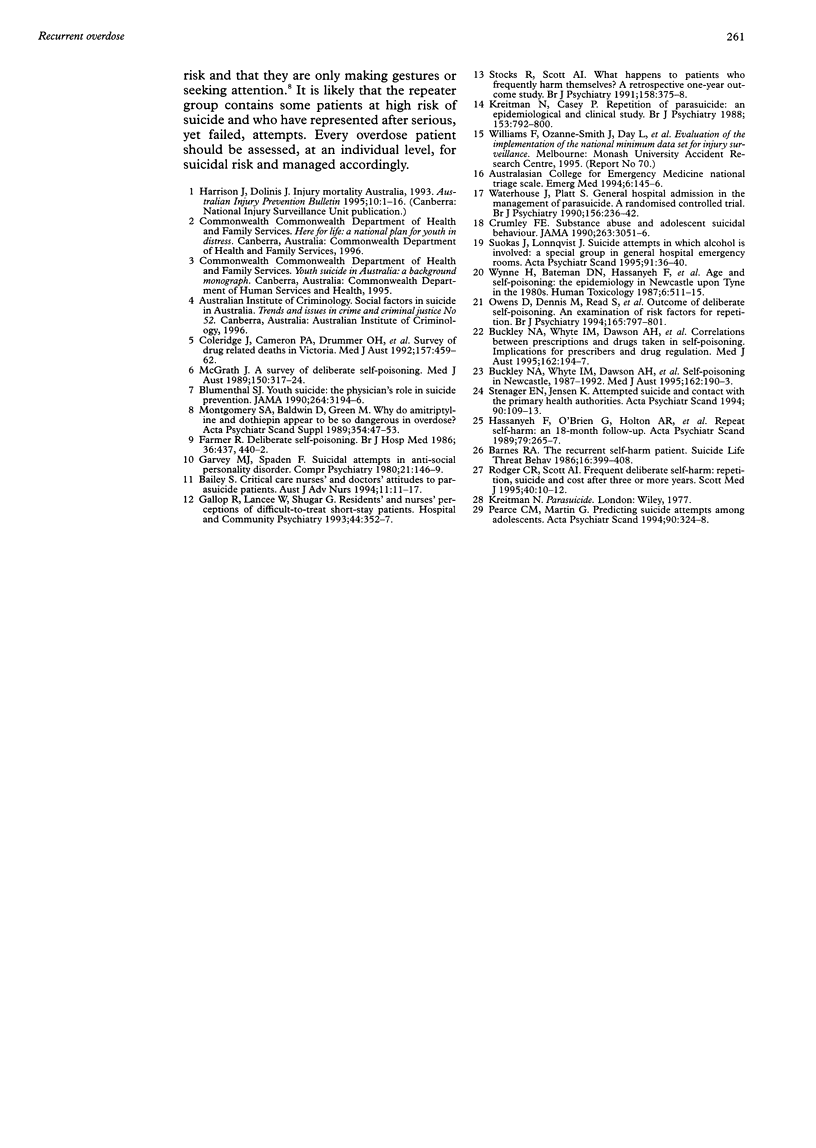Abstract
OBJECTIVES: Patients who overdose repeatedly on drugs and poisons (repeaters) are of major concern. This study aimed to examine the demographics, types of drugs ingested, associated self inflicted trauma, and medium term outcome of repeaters and to compare these patients with those who overdosed on one occasion only (single presenters) during the study period. METHODS: The study was undertaken in the emergency department of a large, provincial Australian hospital. A retrospective case note examination was made for all patients who presented, after drug overdose, during the two year study period. These patients were also followed up for a further 12 months after the study period. RESULTS: The study identified 335 single presenters and 46 repeaters. Females formed about two thirds of each group but repeaters tended to be older (p > 0.05) and to present more frequently before midnight (p > 0.05). Significantly more repeat presentations were triaged to the low priority categories 4 or 5 (odds ratio (OR) 0.48; 95% confidence interval (CI) 0.26 to 0.90, p = 0.023) and this group required fewer admissions to the hospital (OR 1.85; 95% CI 1.16 to 2.93, p = 0.009). Repeaters tended to take single drug overdoses. There were significantly more paracetamol only overdoses (OR 0.54; 95% CI 0.32 to 0.92, p = 0.024) and neuroleptic only overdoses (OR 0.27; 95% CI 0.11 to 0.67, p = 0.005) in the repeater group. More repeaters caused self inflicted trauma during the study period (OR 0.20; 95% CI 0.06 to 0.64, p = 0.007). No repeater completed suicide during the study or the 12 month follow up periods but repeaters presented more frequently, after overdose, during follow up (OR 0.38; 95% CI 0.13 to 1.11, p = 0.078). CONCLUSIONS: The study concludes that there are some significant differences between patients who overdose repeatedly and those who overdose on one occasion only. The study findings suggest that the medium term suicidal risk for repeaters is relatively low. However, this risk will vary and individual patients must be assessed thoroughly and managed accordingly.
Full text
PDF




Selected References
These references are in PubMed. This may not be the complete list of references from this article.
- Bailey S. Critical care nurses' and doctors' attitudes to parasuicide patients. Aust J Adv Nurs. 1994 Mar-May;11(3):11–17. [PubMed] [Google Scholar]
- Barnes R. A. The recurrent self-harm patient. Suicide Life Threat Behav. 1986 Winter;16(4):399–408. doi: 10.1111/j.1943-278x.1986.tb00726.x. [DOI] [PubMed] [Google Scholar]
- Blumenthal S. J. Youth suicide: the physician's role in suicide prevention. JAMA. 1990 Dec 26;264(24):3194–3196. [PubMed] [Google Scholar]
- Buckley N. A., Whyte I. M., Dawson A. H., McManus P. R., Ferguson N. W. Correlations between prescriptions and drugs taken in self-poisoning. Implications for prescribers and drug regulation. Med J Aust. 1995 Feb 20;162(4):194–197. [PubMed] [Google Scholar]
- Buckley N. A., Whyte I. M., Dawson A. H., McManus P. R., Ferguson N. W. Self-poisoning in Newcastle, 1987-1992. Med J Aust. 1995 Feb 20;162(4):190–193. doi: 10.5694/j.1326-5377.1995.tb126020.x. [DOI] [PubMed] [Google Scholar]
- Coleridge J., Cameron P. A., Drummer O. H., McNeil J. J. Survey of drug-related deaths in Victoria. Med J Aust. 1992 Oct 5;157(7):459–462. doi: 10.5694/j.1326-5377.1992.tb137307.x. [DOI] [PubMed] [Google Scholar]
- Crumley F. E. Substance abuse and adolescent suicidal behavior. JAMA. 1990 Jun 13;263(22):3051–3056. [PubMed] [Google Scholar]
- Farmer R. Deliberate self-poisoning. Br J Hosp Med. 1986 Dec;36(6):437, 440-2. [PubMed] [Google Scholar]
- Gallop R., Lancee W., Shugar G. Residents' and nurses' perceptions of difficult-to-treat short-stay patients. Hosp Community Psychiatry. 1993 Apr;44(4):352–357. doi: 10.1176/ps.44.4.352. [DOI] [PubMed] [Google Scholar]
- Garvey M. J., Spoden F. Suicide attempts in antisocial personality disorder. Compr Psychiatry. 1980 Mar-Apr;21(2):146–149. doi: 10.1016/0010-440x(80)90092-9. [DOI] [PubMed] [Google Scholar]
- Hassanyeh F., O'Brien G., Holton A. R., Hurren K., Watt L. Repeat self-harm: an 18-month follow-up. Acta Psychiatr Scand. 1989 Mar;79(3):265–267. doi: 10.1111/j.1600-0447.1989.tb10256.x. [DOI] [PubMed] [Google Scholar]
- Kreitman N., Casey P. Repetition of parasuicide: an epidemiological and clinical study. Br J Psychiatry. 1988 Dec;153:792–800. [PubMed] [Google Scholar]
- McGrath J. A survey of deliberate self-poisoning. Med J Aust. 1989 Mar 20;150(6):317-8, 320-1, 324. doi: 10.5694/j.1326-5377.1989.tb136492.x. [DOI] [PubMed] [Google Scholar]
- Montgomery S. A., Baldwin D., Green M. Why do amitriptyline and dothiepin appear to be so dangerous in overdose? Acta Psychiatr Scand Suppl. 1989;354:47–53. doi: 10.1111/j.1600-0447.1989.tb03046.x. [DOI] [PubMed] [Google Scholar]
- Owens D., Dennis M., Read S., Davis N. Outcome of deliberate self-poisoning. An examination of risk factors for repetition. Br J Psychiatry. 1994 Dec;165(6):797–801. doi: 10.1192/bjp.165.6.797. [DOI] [PubMed] [Google Scholar]
- Pearce C. M., Martin G. Predicting suicide attempts among adolescents. Acta Psychiatr Scand. 1994 Nov;90(5):324–328. doi: 10.1111/j.1600-0447.1994.tb01601.x. [DOI] [PubMed] [Google Scholar]
- Rodger C. R., Scott A. I. Frequent deliberate self-harm: repetition, suicide and cost after three or more years. Scott Med J. 1995 Feb;40(1):10–12. doi: 10.1177/003693309504000104. [DOI] [PubMed] [Google Scholar]
- Stenager E. N., Jensen K. Attempted suicide and contact with the primary health authorities. Acta Psychiatr Scand. 1994 Aug;90(2):109–113. doi: 10.1111/j.1600-0447.1994.tb01564.x. [DOI] [PubMed] [Google Scholar]
- Stocks R., Scott A. I. What happens to patients who frequently harm themselves? A retrospective one-year outcome study. Br J Psychiatry. 1991 Mar;158:375–378. doi: 10.1192/bjp.158.3.375. [DOI] [PubMed] [Google Scholar]
- Suokas J., Lönnqvist J. Suicide attempts in which alcohol is involved: a special group in general hospital emergency rooms. Acta Psychiatr Scand. 1995 Jan;91(1):36–40. doi: 10.1111/j.1600-0447.1995.tb09739.x. [DOI] [PubMed] [Google Scholar]
- Waterhouse J., Platt S. General hospital admission in the management of parasuicide. A randomised controlled trial. Br J Psychiatry. 1990 Feb;156:236–242. doi: 10.1192/bjp.156.2.236. [DOI] [PubMed] [Google Scholar]
- Wynne H., Bateman D. N., Hassanyeh F., Rawlins M. D., Woodhouse K. W. Age and self-poisoning: the epidemiology in Newcastle upon Tyne in the 1980s. Hum Toxicol. 1987 Nov;6(6):511–515. doi: 10.1177/096032718700600611. [DOI] [PubMed] [Google Scholar]


